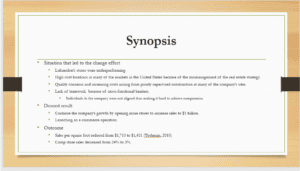Analysis of Lululemons Case Organizational Change
Hello. Welcome to my presentation on Lulumelon’s case study.
Lulumelon was experiencing various challenges that created a need for change. Firstly, the company’s stores were underperforming. The second issue was the high cost of locations in many markets in the United States because of the mismanagement of the real estate strategy (Tushman,2010). The third problem was quality concerns and increasing costs arising from poorly supervised construction at many of the company’s sites. The company was also experiencing a lack of teamwork because of cross-functional barriers. Individuals in the company were also not aligned, thus making it hard to achieve compromise (Tushman, 2010). The desired result was to continue the company’s growth by opening more stores to increase sales to $1 billion and launch an e-commerce operation. However, the outcome was favorable. According to Tushman (2010), sales per square foot reduced from $1,710 to $1,451, and comp-store sales decreased from 24% to 3%.
Lulumelon used the remedial change organizational change strategy. According to Tahir (2020), the remedial change strategy includes identifying a problem and solution that should be implemented. The company took various measures to implement the change. One of the measures was training employees to help them set goals, educate them about the company’s culture, and equip them with the skills they could use to enhance personal accountability. The second measure was customizing stores to reflect local communities. The third measure was restructuring the organizational structure to improve the organization’s leadership.
The two things that were done successfully were training employees and leadership changes. The training enabled the company to equip employees with the knowledge and skills needed to align their behavior and actions with the company culture. Leadership changes were necessary because Bob Meers’ leadership did not consider the company’s goals and objectives. For instance, he appointed various outsiders to form the company’s upper management team, leading to poor leadership and management of the organization’s operations. Christine Day, the new CEO, could use her leadership expertise to enhance the organization’s performance and adapt to the changes in the organization’s business environment.
One of the things that could have been done differently was growth and expansion. The company focused on growth and expansion by giving managers authority to customize their stores. This action created the risk of mismanagement of resources and conflicts of interest, especially if the stores are located in a region where local communities have different preferences, values, and beliefs. The alternative solution would have been ensuring that the authority to customize the stores is only granted to the CEO for proper allocation of resources and centralized decision-making in determining whether the customization is necessary and its impact on sales.
One of the things that was done well was the value proposition. The company effectively created value for customers by ensuring that its products helped people live more exciting, healthier, and longer lives. It also designed technical accessories and garments around athletes’ needs based on feedback from different sources. The second thing that was done well was employee training and development. The company handled training and development by sponsoring new hires’ attendance at a three-day session by Landmark Education, which motivated staff by making them feel appreciated. The company also trained new hires to educate them on personal goals, help them define goals, and comprehend the workplace culture.
One of the lessons I learned from the case study is that leadership can impact the choice of organizational changes and how they should be implemented. For instance, Bob Meers’ leadership decreased as a result of poor leadership, which created underperforming issues. Bob Meers’ leadership also reduced collaboration in the company because he appointed outsiders to hold top management positions. The second lesson is that training is essential in educating changes in the organization’s culture because it creates a shared sense of direction and a sense of belonging among employees, thus increasing their willingness to ensure the change is successful.
ORDER A PLAGIARISM-FREE PAPER HERE
We’ll write everything from scratch
Question
The final assessment is an analysis of Lululemon’s case organizational change.
You should develop an analysis of 6-8 slides. The slides should be in APA format, which includes citing the information that informs your analysis. If the slides are not self-explanatory, then an explanation should be provided in the notes section of the slide.
Analysis of Lululemons Case Organizational Change
• A brief synopsis of what occurred at Lululemon, including the situation that led to the change effort, the desired results, and the outcome.
• The organizational change strategy that Lululemon leadership used to plan and implement change.
• What did you think was successful, and what would you have done differently?
• Your own observations of what was done well and what you would have done differently if you were leading.
• Two or three lessons learned from the case study that demonstrate you have the problem-solving skills necessary for ethical and effective change management.
Formatting
• Length: Your project should comprise 6-8 slides with accompanying speaker notes. Points will be deducted for submissions that exceed the specified length.
• APA format:









